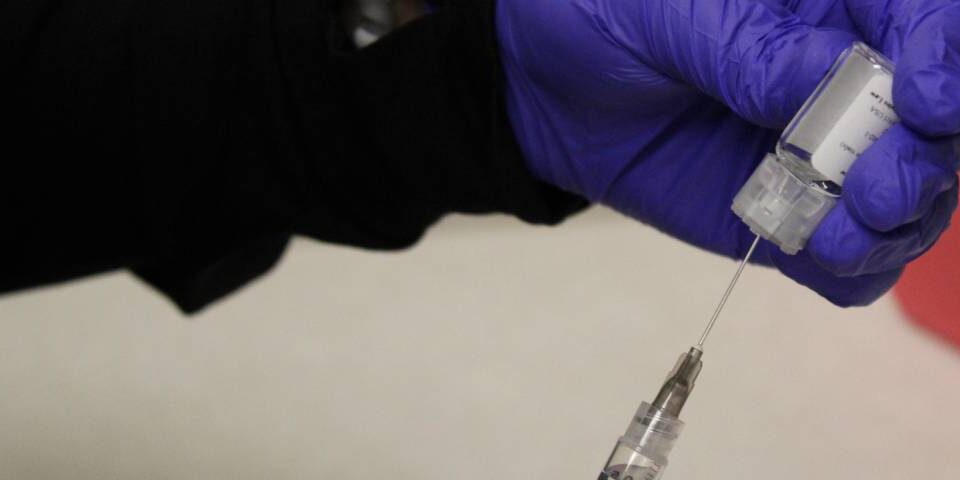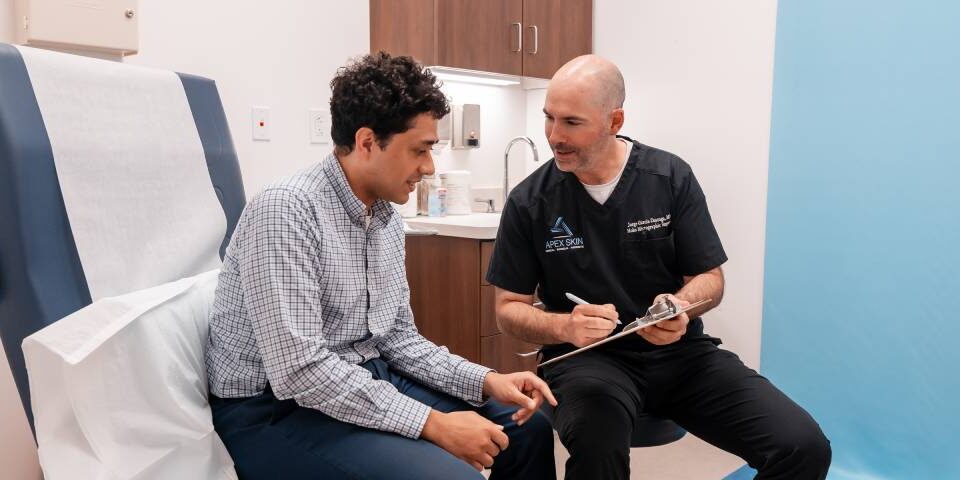
Gorlin Syndrome: Understanding the Condition and Exploring New Treatments
December 5, 2024
Inside the Itch: Exploring Chronic Urticaria and Innovative Treatments
February 13, 2025Imagine dealing with an open wound that never seems to heal. It starts innocuously—a sore rash that begins with a blood blister. This alarming-looking condition is known as pyoderma gangrenosum (PG), a rare and chronic ulcerative skin disorder. Despite its name, PG isn’t contagious, nor is it related to gangrene. It typically appears on the legs but can surface on other hairy areas of the body, often leaving behind intense scars.
For those struggling with PG, the physical pain is compounded by the emotional toll of an elusive diagnosis and mysterious sores that refuse to resolve. Dermatologists play a critical role in managing PG, but more advanced care is often necessary for lasting relief. At Apex Clinical Research Center, we’re committed to helping patients find answers and healing through focused care and groundbreaking research, including our dedicated pyoderma gangrenosum clinical trial.
What is Pyoderma Gangrenosum?
Pyoderma gangrenosum is an ulcerative neutrophilic dermatosis disorder. Let’s break down this term for clarity. First, neutrophilic means that your body has created too many neutrophils, which are one of five types of white blood cells your body uses to fight infection by causing an acute inflammatory response. When the danger is over, however, these neutrophils keep fighting, attacking healthy tissues instead. Pyoderma gangrenosum causes painful, open sores to develop as a result. This disorder shows up on the skin as an autoimmune inflammatory disease that attacks the skin cells as if they were the problem, hence the painful, open sores that won’t go away.
Some neutrophilic dermatoses seem to appear for no reason at all that you can think of, while others appear at injury sites like where there was a needle prick, insect bite, cut, or biopsy incision. Scientists are not sure what the conclusive pyoderma gangrenosum causes are, but there is evidence of a genetic predisposition for it.
Pyoderma gangrenosum is rare—only about 6 people in every 100,000 experience it. From the research we have, about half of those cases of PG occur alongside other autoimmune disorders such as inflammatory bowel disease, Crohn’s disease, rheumatoid arthritis, and other autoimmune conditions. Twice as many women as men suffer from it, and it’s most common in middle age. It seems to occur equally between people with light and dark complexions.
As rare as it is, PG causes significant physical and emotional suffering for those who struggle with it. This is why additional research into the causes and better treatment for pyoderma gangrenosum is so important.
Pyoderma Gangrenosum Symptoms and Diagnosis
Diagnosing pyoderma gangrenosum can be a real challenge that prolongs patient suffering. Experiencing an open, ulcerative wound that refuses to respond to self-care at home while becoming increasingly painful and deep is incredibly distressing! Although there is no specific test for PG, an experienced dermatologist can diagnose it based on careful evaluation of the symptoms and your medical history, such as other autoimmune disorders that can appear with PG. Diagnosis also involves ruling out other potential conditions such as infections or vasculitis. The most common pyoderma gangrenosum symptoms include:
- Painful pustules that start as spider-bite-like, pimple-like, or blood-blister-like spots and evolve into deep, necrotic ulcers with purplish borders around the outside.
- Ulcers that appear suddenly, often triggered by minor injuries like pinpricks or insect bites.
- Lesions typically develop on the legs but can occur anywhere on the body.
- The condition can present as a single ulcer or multiple ulcers simultaneously.
- Ulcers that progress rapidly and cause significant pain.
If you are suffering from any symptoms like these, regardless of what you think they might mean, do not hesitate to schedule an appointment to see a dermatologist with the clinical expertise to know what to look for.
Current Pyoderma Gangrenosum Treatment Options
Currently, treatment for pyoderma gangrenosum focuses on relieving swelling, providing pain relief, and stimulating the wounds to heal. Under the care of your dermatologist, the sores can improve and heal. Treatment includes corticosteroids, immunosuppressive drugs, biologics, and wound care that addresses how bad the sores are, how many you have, and any other concurrent health conditions that need to be addressed. In rare cases, surgery may be necessary.
Corticosteroids
Your dermatologist may recommend topical or oral corticosteroids like prednisone in order to address the inflammatory response causing the wounds. Corticosteroids can only be taken for a limited time to prevent serious side effects. They cannot address long-term problems.
Immunosuppressive Drugs
Another possible treatment for pyoderma gangrenosum is the use of immune-suppressing drugs that halt the self-destructive auto-immune response where your immune system attacks your own skin. Steroid-sparing drugs including immunoglobulins, cyclosporine, dapsone, infliximab, mycophenolate, and tacrolimus are possible options, depending on your needs. These medications can be injected, applied topically, or taken orally. Each of these drugs can have severe side effects, so it’s important to remain in close contact with your dermatologist during treatment.
Biologics
Recently developed biologics are medications developed from proteins, genetic material, and cellular lifeforms that can be tailored more closely to patient needs. This is a new and exciting field of research for pyoderma gangrenosum treatment, but it can be prohibitively expensive to try these medications in typical dermatological settings.
Wound Care and Pain Relief
While other medications address inflammation and immune regulation, it’s also important to maintain good wound care practices to prevent infection and stave off the growth of the ulcers if at all possible. Your dermatologist may assist with applying medicine and then covering ulcers with a non-stick wound dressing. Keeping the affected area elevated can help with swelling. It’s important to follow your dermatologist’s wound care instructions, which may involve ibuprofen for pain relief.
Limitations of Current Pyoderma Gangrenosum Treatments
To sum up the available treatments for pyoderma gangrenosum, your dermatologist can help you get relief to clear up the lesions, but each different treatment option comes with limitations and side effects, especially if needed for long-term use. Also, none of these current treatments are specifically approved by the FDA for treating PG, although they can be used. This is why Apex Clinical Research Center is working on a pyoderma gangrenosum clinical trial in order to find better, more effective, less side-effect-inducing ways to relieve PG.
This Pyoderma Gangrenosum Clinical Trial is the Key to Progress
Clinical trials are an exciting way for patients and researchers to work together with the goal of closing gaps that currently exist in pyoderma gangrenosum treatment. Apex Clinical Research Center researchers are testing innovative therapies designed to target PG more effectively and specifically so that patients can have more relief, fewer flareups, and a better recovery course. We want PG patients to have the hope that life can get better for them, and we want to reach that reality together. Clinical trials contribute to the future of patient care, now and for the coming generations.
Patients who participate in our pyoderma gangrenosum clinical trial also receive important benefits besides knowing that they are helping themselves and future patients get more relief and better patient outcomes. The drug and care provided during the study are free of charge for the patient, and patients receive extra close monitoring and care for their time. This brings a lot of hope for pain relief and healing from PG.
Apex Clinical Research Center’s Role in Advancing Treatment for Pyoderma Gangrenosum
This clinical trial involves an IV-infusion drug called Vilobelimab for Ulcerative Pyoderma Gangrenosum. It is a blind, placebo-controlled study, so some study participants will receive the drug, and others will receive a placebo.
Vilobelimab (IFX-1) is a first-in-class monoclonal anti-human complement factor C5a antibody that blocks the biological activity of C5a highly and effectively. C5a is a molecule in the body that participates in acute inflammation that may cause local skin inflammation and tissue damage seen in PG skin ulcers.
The hope is that patients taking Vilobelimab will have complete closure of their ulcers, decreased pain, and regression of the disease.
Eligibility Requirements
To be included in this clinical trial, participants must be at least 18 years old and have a confirmed clinical diagnosis of ulcerative Pyoderma Gangrenosum. The ulcer must have a square area greater than or equal to 5 centimeters during the screening and baseline. It must be surrounded by intact skin and measurable by an at least 2-dimensional measurement. All participants will enjoy intensive dermatological care and thorough safety precautions.
Find Out if You are Eligible for the Pyoderma Gangrenosum Clinical Trial
If you have been scarred by pyoderma gangrenosum, or are currently fighting an ulcerative wound from PG, seek dermatological care right away, and contact us here at Apex Clinical Research Center to see if you qualify for the clinical trial. We are committed to providing relief, healing, and hope for everyone along their journey, whether it’s through advancing existing treatments or discovering new ones through clinical trials.





